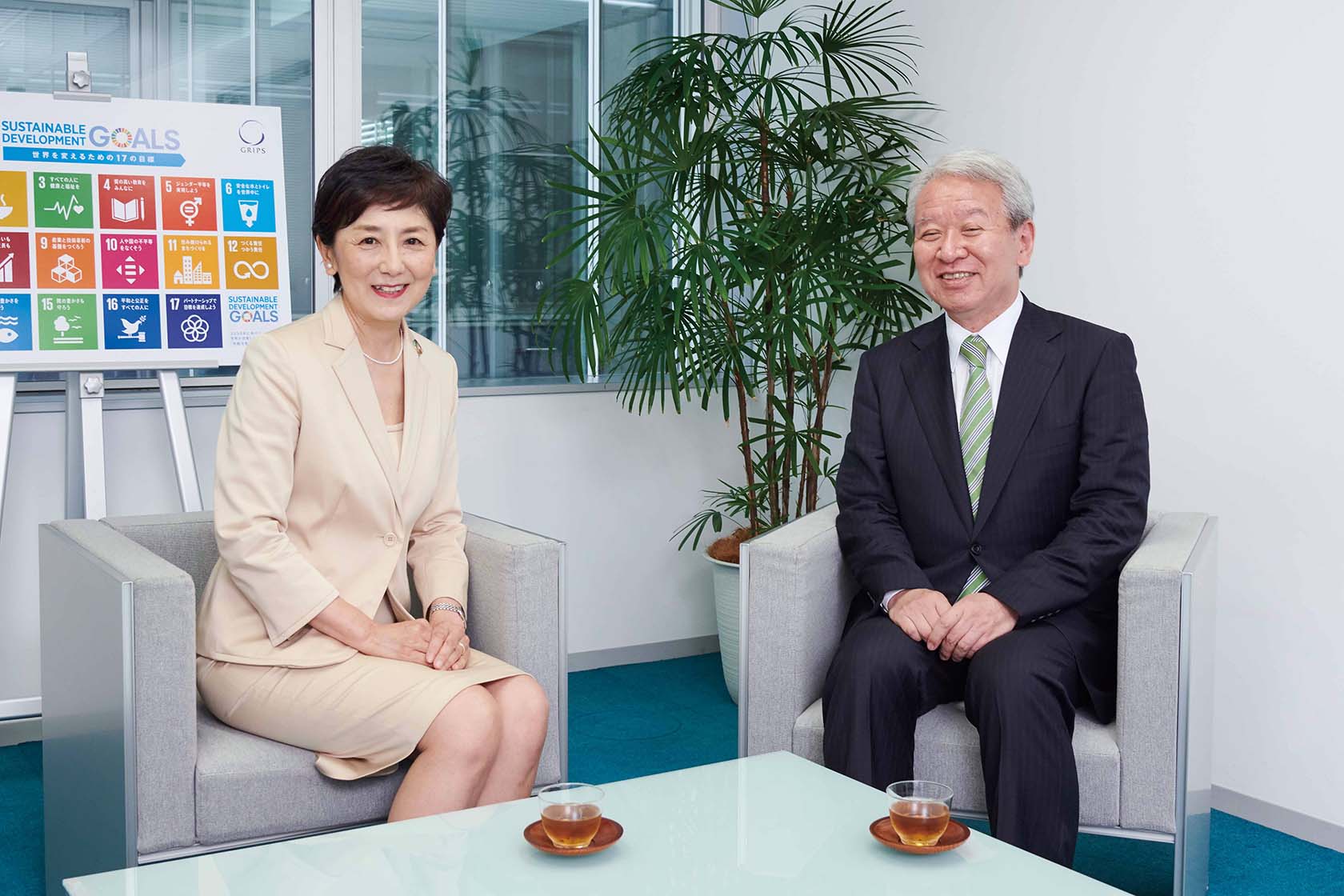Pensée Talk #2
Hiroko Kuniya (Goodwill Ambassador, Food and Agriculture Organization of the United Nations) × Akihiko Tanaka (President, GRIPS)
(From the November 26, 2018 edition of Pensée)
For this second edition, we asked Ms. Kuniya, a news anchor and journalist now also serving in key roles including UN Food and Agriculture Organization (FAO) Goodwill Ambassador for Japan, to share her perspective with us. Ms. Kuniya is working tirelessly to gather information and educate the public about the sustainable development goals (SDGs) adopted by the United Nations as agenda to be shared by the whole world. She talked with GRIPS President Tanaka about approaches to and policies supporting the resolution of issues related to the SDGs.
A great number of efforts are being made to realize the SDGs, even by local governments.
—Ms. Kuniya, I understand that your interest in the SDGs deepened through your involvement in a number of activities, particularly your coverage in 2015 of the 70th anniversary of the first meeting of the United Nations General Assembly, and your dialogue with Ms. Amina Mohammed, Deputy Secretary General of the UN, who worked long and hard for adoption of the SDGs. What sort of approaches are you currently taking in your work to advance the SDGs?
Kuniya I have been involved in gathering information and educating the public about the SDGs ever since I left the TV program Close-up Gendai. According to a survey by one newspaper company, only 12 to 15 percent of Japanese people know of the SDGs. That’s a rather low level of awareness. In contrast, recently we have seen brisk SDG-related activity by companies here. There is growing momentum now that would have been unimaginable two years ago. Local governments have also begun to take action, so much so that we have our hands full gathering all the emergent information. We cannot spread the word about excellent approaches and models without going out and getting the facts. In that sense information collection and ongoing learning are essential. My work as Goodwill Ambassador of the FAO gives me many opportunities to learn in depth about food supply problems and agricultural problems. As a project professor at Keio University, I also visit local governments with my students for discussion to explore promising and appropriate problem-solving schemes.
—What sorts of SDG related activities are under way among local governments?
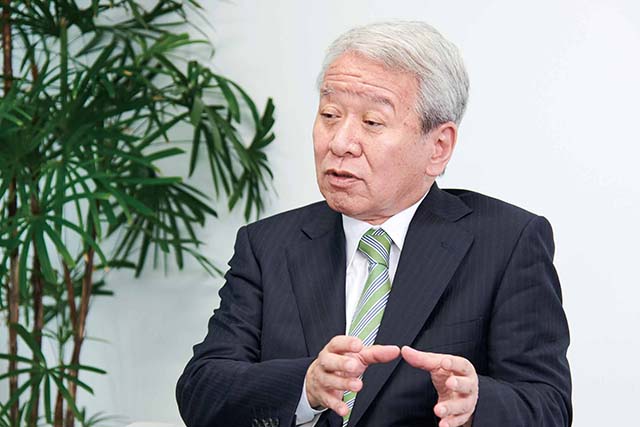
Kuniya For many local governments, declining population is the biggest concern. The town of Shimokawa-cho in Hokkaido, which received Japan’s SDG Award, has adopted the approach of creating an autonomous circular economy using local forestry resources, rather than looking to amalgamate with other municipalities. The citizens of Shimokawa-cho grow trees, and at the same time they harvest the forests. They make laminated wood and charcoal, and produce wood chip biomass for use as heating fuel. They have focused on the use of local resources, and they are working steadily to generate earnings and create employment for the community with those resources. That scheme is finally starting to produce substantial results. I wondered how a community with a population of only about 3,400 managed to achieve those results, so I went there to conduct investigative interviews. The people there are actively working to create a sustainable community. The town is sending officials to the Japanese Cabinet Office and the Ministry of the Environment, and approaching companies and researchers for assistance with technical issues.
At the same time, there are communities where dialogue on the subject of the SDGs has just begun. The Takahashi district of Toyooka City in Hyogo Prefecture is facing a population problem: given the current trend, Toyooka’s present population of around 800 is projected to shrink to about 100 by 2050. With a sense of crisis about the prospect of the disappearance of the district, a group of professors and students traveled to Toyooka and began talking with its residents. I was happy to be able to join in that effort. It is clear that input in the form of external views can prompt the residents to do some proactive thinking about the situation in their locale.
Tanaka A sense of crisis like this existed in the background when the SDGs were born. However, there was an emergent hope that something could be done. Among the millennium development goals (MDGs), which set targets to be achieved globally by 2015, the goal of reducing the number of people in extreme poverty by half during the period 1990 to 2015 was achieved in many countries. People have begun to think that we can resolve critical situations through global cooperation.
The nice thing about the SDGs is that they are comprehensive in content and provide a lingua franca, a common language which people can use to address those goals. The SDGs facilitate the comparison of different approaches and shared learning from excellent activities. In that atmosphere, people can come to see that the rest of the world shares their concerns about these issues. In the context of that awareness, the sharing of methodologies that have yielded solutions in one locale may well lead to the resolution of issues elsewhere.
Kuniya The existence of the 17 goals facilitates dialogue. The SDGs help to identify essential issues so that discussions can proceed without degenerating into misdirection.
It would be difficult to effect straight-line solutions to the complex problems facing the world.
Tanaka Since the adoption of the SDGs in 2015, we see improvement regarding many of the goals, but we also see difficulties with some of them. Global statistics indicate that over the last two or three years, there has been improvement in the infant mortality rate and the maternal mortality rate. The percentage of mothers who can be attended to by physicians and nurses at the time of childbirth is rising. On the other hand, the world hunger rate is rising. Conceivable reasons for that include the increase in the number of refugees, and problems related to climate change. In the field of health, the incidence of malaria is on the rise. I am mentioning cases from the field of health and hygiene as examples here, but my point is more general: the problems of the world are not going to be solved in a linear fashion. We must constantly monitor each situation in the context of the world as a whole.
—Ms. Kuniya, I believe that in your capacity as FAO Goodwill Ambassador you are also involved in discussions on hunger and other issues related to food supply. What kind of role can Japan play?
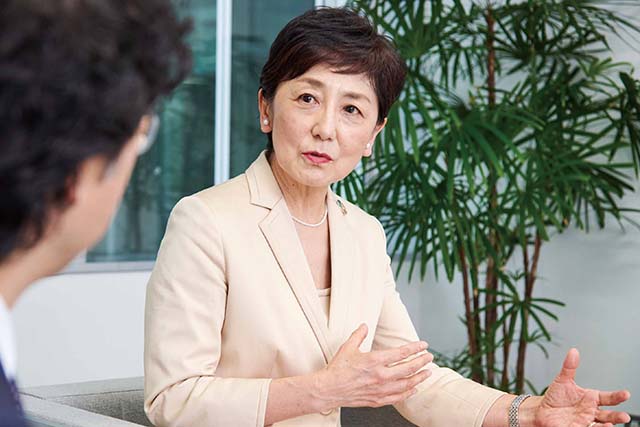
Kuniya Japan wastes an extremely large volume of food. In the past year, Japan discarded 28.42 million tons of food, including a remarkable 6.46 million tons of that food was still edible. Food assistance worldwide totaled about 3.2 million tons in 2015: the volume of still edible food that Japan throws away annually is about twice the yearly volume of that assistance. The number of people classified as hungry worldwide increased by over 30 million in the one-year period from 2015 to 2016, and now tops 800 million. In this situation, with a food self-sufficiency rate of 38 percent, Japan is throwing away massive amounts of food, and using huge amounts of the water resources, soil resources, and labor of other countries to have its food produced there. The question of how to confront this situation is a key agendum.
Meanwhile, attention is again coming to focus on the possibility that agriculture and forestry practices can contribute to measures to address climate change. Soil can capture carbon, but depending on the method, agriculture can end up releasing that trapped carbon. It is important to aim for zero carbon emissions and switch to renewable energy, but presumably it is also important to reform farming and recover the forests, and at the same time encourage farmers to take advantage of nature’s capacity to adsorb carbon dioxide from the atmosphere.
Tanaka To advance the SDGs, we need a movement that engages countries, organizations, companies, and other stakeholders to mobilize maximum resources. Many people should cooperate to achieve these common goals. In some cases, however, those actions may not have any effect or may even have the opposite effect to that intended. This is precisely why we at GRIPS, who are engaged in policy studies, are striving to identify effective policy which, when applied, would lead to the achievement of the goals. We are mobilizing all our knowledge along with other experts’ expertise in the spheres of natural science and engineering, bringing that to bear in research to identify effective social policy, and sharing the findings of that research with society at large. As I see it, this kind of input, giving policy-related advice to society, is a major element of the GRIPS mission.
Conflicts of interest in the problem-solving process test the skills of policy researchers.
Kuniya With the increasing attention on environmental, social and governance (ESG) investment, I believe investors, too, are searching for investment destinations that will simultaneously contribute to the resolution of issues and enhance the development of business. Some of the key policymaking questions here revolve around how to provide incentives and where to impose penalties. For example, consider the problem of plastic waste dumped into the sea. Norway has launched a system of rewards and penalties related to the use of plastic bottles for drinking water. That system consists of two schemes: giving refunds to consumers who return plastic bottles; and imposing penalties on companies selling them. The corporate penalty is reduced to zero if the company recycles at least 98 percent of the plastic bottles it sells. Thanks to that combination of rewards and penalties, plastic bottles are reportedly being reused as many as 50 times in Norway.
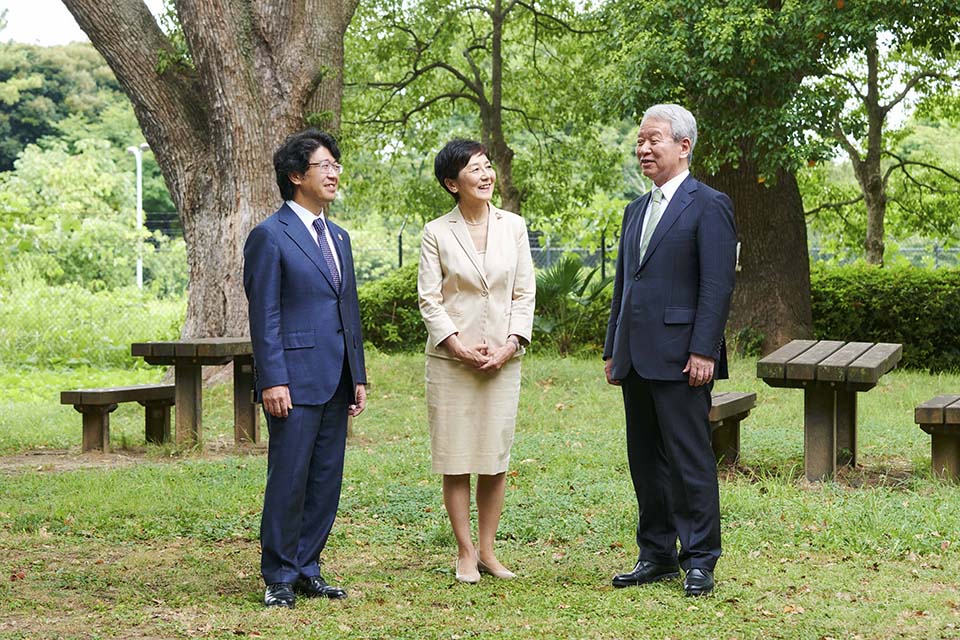
Tanaka That’s a case of a successful policy of incentives and penalties.
Kuniya Yes, it’s encouraging. It’s not always simple, though: here’s another case of insufficient incentive. The lack of recharging stations along roads is often mentioned as one of the reasons why electric vehicles have not yet seen widespread diffusion. It was thought that installing recharging equipment at filling stations would encourage the spread of the technology, but businesses selling gasoline have little interest in the spread of electric vehicles. They have little incentive to install recharging devices.
Tanaka Conflicts of interest like that are often encountered in efforts to resolve issues tied to the SDGs. Although many parties may agree on the goals, conflicts of interest are liable to arise in the process of implementation. We must design necessary and effective policies on the assumption that some kind of conflicts could arise. Solutions proposed by engineers and economists may not resolve conflicts among stakeholders. In such a case, we need to take into account political aspects of society when we devise policy.
KuniyaAchieving paradigm shifts is a major challenge.
We need paradigm shifts based on mutual learning by developed and developing countries.
Kuniya If we look at various cases of work towards the SDGs we see that developing countries are implementing leading-edge measures and taking approaches based on ideas that are very different from those of developed countries.
TanakaThere used to be a strong tendency for developed countries to work from the viewpoint of “teaching” developing countries, but comparison of the various approaches to achieving the SDGs as global agenda reveals that the approaches taken by developed countries are not necessarily superior. We have a window on that at GRIPS, since we are so lucky as to have international students and Japanese students engaging in shared discussion of regional approaches.
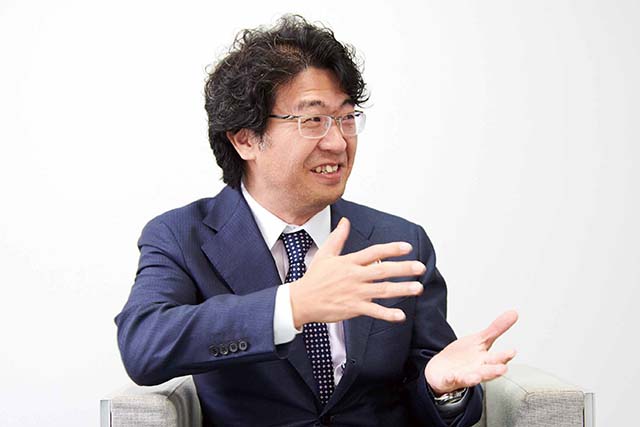
Kuniya The town of Ama-cho in Shimane Prefecture is attempting to halt its population decline by making its educational services more attractive. When I visited Ama-cho to gather information, I found someone from the Japan International Cooperation Agency (JICA) working there. I asked him why he was working in Japan, and he replied, “The approaches being taken in this region are linked to the solution of issues in other Asian countries. This place is at the forefront of problem-solving in the context of population decline.” I was really stricken by this. If we look at things from the perspective of the SDGs, it is hard to tell which are the developing countries and which are the developed ones.
Tanaka When I was President of JICA, we encouraged JICA personnel sent to developing countries to actively engage in mutual learning with the local practitioners on the ground so that they could bring good ideas back to Japan. There were many times when I felt that successes achieved in developing countries ought to be introduced in the outlying regions of Japan as well. This is why we must change our outlook a bit and induce a paradigm shift, even in the case of programs that we classify as aid and development assistance. The SDGs are goals that require collaborative action for the solution of shared problems.
—In the context of GRIPS programs, too, we are addressing inclusive innovation, which is aimed at inducing innovation on the site where the issue arose. The paradigm shift you mentioned may very well become an agendum in various fields.
We want our students to induce change at the national and local levels after completing their studies at GRIPS.
—There are various SDG related activities under way. What is your agenda for even greater focus in the future?
Tanaka For me, a very important item is SDG 16, that is, “Peace, Justice, and Strong Institutions.” For example, if civil wars cannot be stopped, absolutely no progress is going to be made on other problems either. While all the SDGs are vital, I think that the people serving in international politics in particular must do their very best to build peace. As a related development, I might mention the enactment of the Bangsamoro Organic Law in the Philippines, under the administration of President Duterte. If all goes well, the strife that has been going on for some 40 years there may be heading towards resolution. As JICA made substantive efforts to consolidate peace in the Mindanao region of the Philippines, I am personally very gratified by this positive move.
Kuniya Japan is lagging very far behind with regard to SDG 5, “Gender equality.” For example, in areas with declining populations, fewer women return to their hometowns after receiving a higher education elsewhere. This is because in many cases wowen feel that the deep-seated mindset leaning toward a gender-based division of roles will prevent them from exercising their talents if they return, or that they will have few opportunities for self-fulfillment. I believe that we must achieve gender equality if we are to mitigate the problem of population decrease as a step towards regional well-being.
—What are your thoughts regarding human resource development at GRIPS?
Tanaka Beginning this October, all students who enter GRIPS will be required to take a course entitled, “The World and the SDGs.” Most of our students are working in local or national government. As such, on their return to the workplace, they will be entrusted with the formulation of national and local policy. We want them to acquire a deep understanding of the SDGs as a common language and to realize that the achievement of a particular SDG can be a vital mission for each of them. It is part of the work of GRIPS to motivate the students to conduct various studies based on the issues awareness that they acquire in the course of their year at GRIPS; our work with the students has to support their efforts to formulate policy at the national and local levels when they return home. We hope that by pursuing the SDGs in their policy work, the graduates will spur innovation in their respective administrations.
Kuniya I have high hopes that upon returning to their communities after studying at GRIPS, these local administrative officers will promote all sorts of innovation and mindset changes.
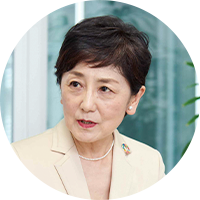 Guest
Guest
Hiroko Kuniya
A graduate of Brown University in the US, Hiroko Kuniya served as the anchor on Close-up Gendai, a current affairs program aired on the NHK General channel, from 1993 to 2016. She has received numerous awards for her work. She was appointed Goodwill Ambassador of the Food and Agriculture Organization of the United Nations (FAO) in May 2017.
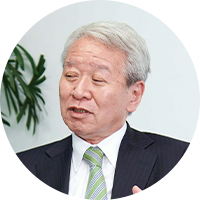
Host
Akihiko Tanaka
Akihiko Tanaka graduated from the University of Tokyo College of Arts and Sciences and from the Graduate School of Political Science of the Massachusetts Institute of Technology. President of GRIPS since April 2017, he has served as Vice-President of the University of Tokyo and President of JICA. His field of special expertise is international politics.
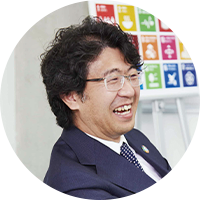
Facilitator
Atsushi Sunami
Atsushi Sunami, GRIPS Vice-President, also serves as Special Advisor to the Cabinet Office and as President of the Sasagawa Peace Foundation Ocean Policy Research Institute.




